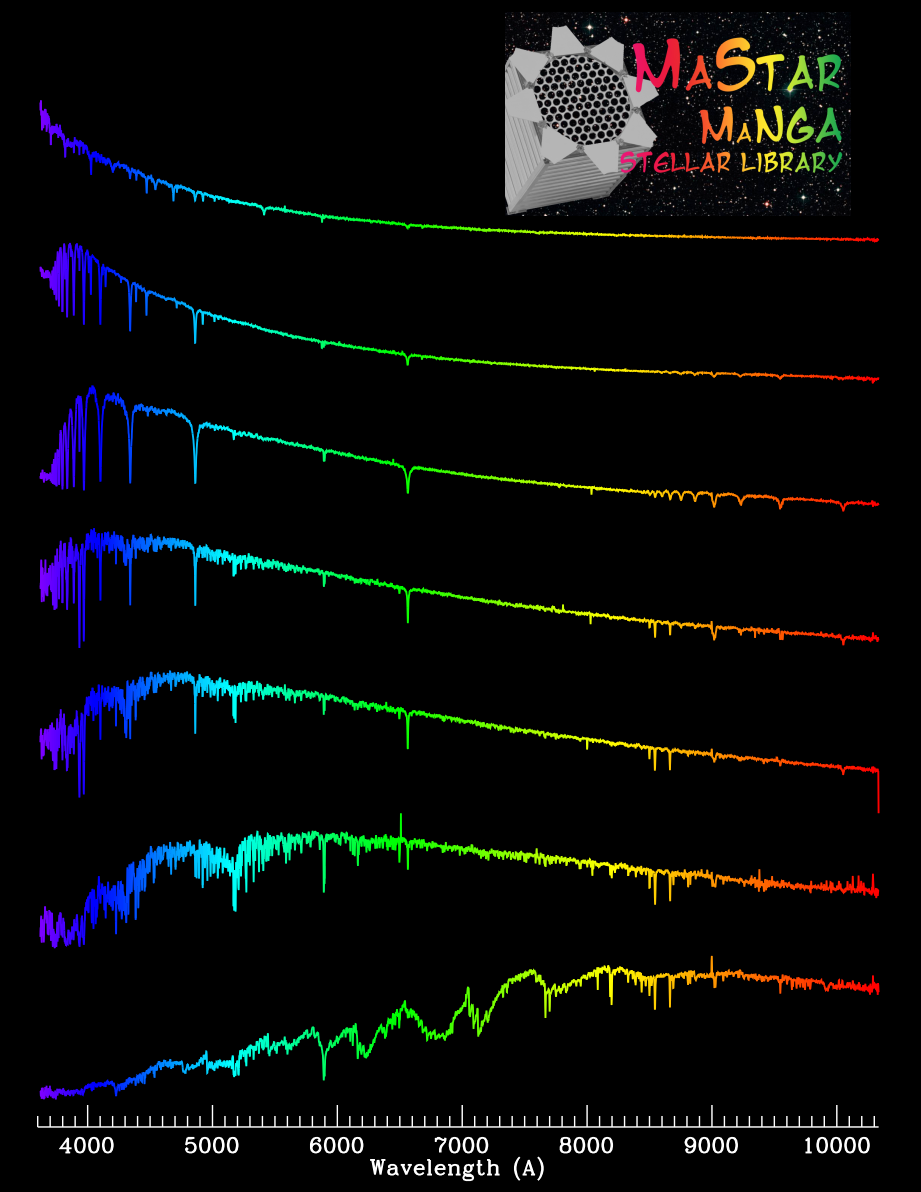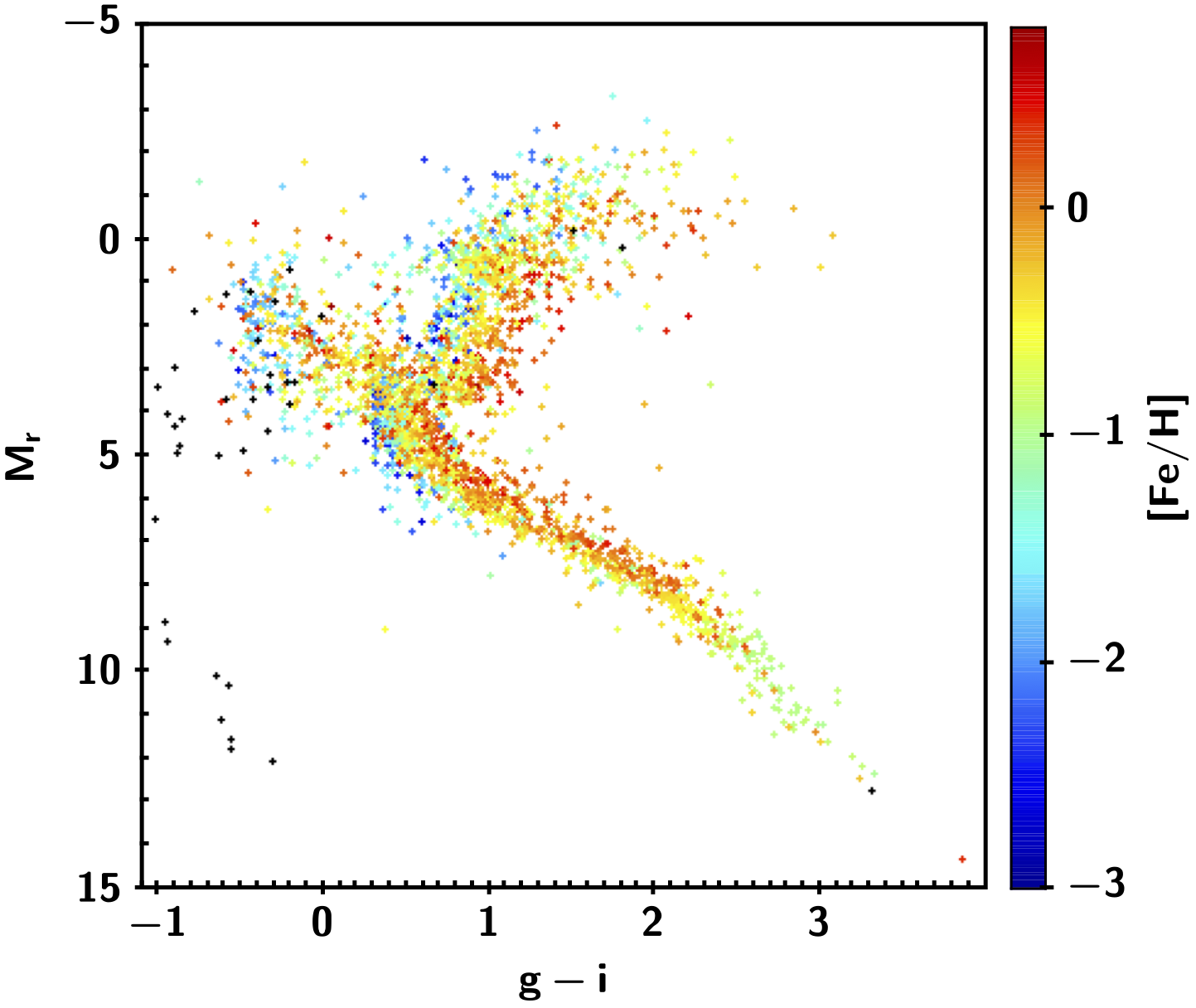MaStar Overview
MaNGA Stellar Library (MaStar) is a stellar spectral library with a wide coverage of stellar parameters, high quality calibration, and identical observing setup as the MaNGA survey.
The spectra cover 3,622-10,354 Angstrom with a spectral resolution around R~1800. The final version will include approximately 10,000 stars. In DR15, we released the first version of the library containing 8646 good quality individual visit spectra for 3321 unique stars, which is only a subset of the final version.
The library is described in detail by Yan et al. (2019). Please cite this paper when using the library, and please also follow the general guide to citing SDSS.
MaStar Observations
The observations are obtained by piggybacking on the APOGEE-2 survey during bright time, using MaNGA fiber bundles and the BOSS optical spectrographs. The use of fiber bundles allow us to obtain much more accurate flux calibration than previous SDSS surveys of stars that use single fibers; see the Observing Strategy page for details of our observations.
For detailed information about the instruments, please see the MaNGA Instrument page.
MaStar Data in DR16
The DR16 version of the MaStar Library is identical to DR15, and is not the final version of the library. We are still accumulating more data and are working on improving the data reduction. This version includes all data obtained in the first three years of observation. Of all the stars observed, we have selected a subset of stars, termed 'good stars', with good quality visit spectra, termed 'good visits'. Each 'visit' is defined as the observation obtained for a star on a single night. This is the primary product of this release. It includes 8,646 good quality single visit spectra for 3,321 unique good stars.
The DR16 release includes a summary file called 'mastarall-(version).fits' and a spectra file called 'mastar-goodspec-(version).fits'. The summary file contains a 'GOODSTARS' table and a 'GOODVISITS' table. The 'GOODSTARS' table lists the ID, location, photometry, input stellar parameters, etc. for all stars with good quality visit spectra. The 'GOODVISITS' table lists the information needed to locate all good quality visits for each star, the radial velocity used to shift each spectrum to restframe, and spectral quality information. The spectra file contains all the good quality single visits spectra, matching the order of entries in the 'GOODVISITS' table.
- The MaStar Catalog page provides the details about the summary file -- 'mastarall'.
- The MaStar Spectra page provides the details about the spectra file -- 'mastar-goodspec'.
- The MaStar Data Access page provides information about ways to access the data.
- The MaStar Caveats page lists important usage caveats for the data. You are strongly encouraged to read this.
- The MaStar Tutorial page provides tutorials for using the MaStar data.
In addition, DR16 also contains the raw data from the first three years of the observations, the intermediate data reduction pipeline (DRP) products, and the combined, flux-calibrated, individual visit and individual exposure spectra.
For more detailed information on the MaStar survey in DR16, see the list of links on this page.
MaStar Data Access
Science Archive Server (SAS)
MaStar individual epoch spectra, individual exposure spectra, and MaStar summary tables are available as FITS files through the Science Archive Server (SAS), which can return FITS spectra either individually or in bulk. For more information on retrieving MaStar data from the SAS, see MaStar Data Access page.
The Science Archive Webapp provides a searchable interface for MaStar spectra, and includes an interactive view of spectra, and a data download facility (supports both rsync and wget).
Sky Server
Information for individual MaStar targets are now shown in the SkyServer Explore tool, such as for this sample MaStar target star.
You can search for MaStar data using Structured Query Language (SQL) with the SkyServer SQL Search tool. MaStar summary data are in the mastar-goodstars table and the mastar-goodvisits table.
CasJobs
You can search for MaStar data within the mastar summary table more flexibly with the CasJobs data access tool. You can save results into a personal MyDB database for later analysis.
MaStar data are part of the DR16 context - don't forget to change to the DR16 context when you want to find MaStar data. MaStar summary data are in the mastar-goodstars table and the mastar-goodvisits table.





